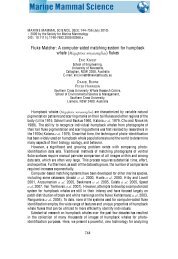Abundance and interchange of humpback whales in Oceania based ...
Abundance and interchange of humpback whales in Oceania based ...
Abundance and interchange of humpback whales in Oceania based ...
Create successful ePaper yourself
Turn your PDF publications into a flip-book with our unique Google optimized e-Paper software.
SC/62/SH18occasions (behaviour, Mb) <strong>and</strong> comb<strong>in</strong>ations <strong>of</strong> these models us<strong>in</strong>g the program MARK. Model fit wasevaluated accord<strong>in</strong>g to the Akaike Information Criterion (AIC), which penalises the likelihood score <strong>of</strong> eachmodel with the number <strong>of</strong> parameters required to fit it. While mark recapture models <strong>in</strong>corporat<strong>in</strong>g genotypeerror (as mis-identification <strong>of</strong> <strong>in</strong>dividuals) are available, errors were exhaustively identified <strong>in</strong> the genotypedataset <strong>and</strong> removed prior to mark recapture analysis. The Type I error <strong>in</strong> this dataset <strong>based</strong> on mis-identificationwas therefore considered to be negligible.In explor<strong>in</strong>g the effect <strong>of</strong> heterogeneity, we assumed that the population conta<strong>in</strong>s a discrete mixture <strong>of</strong> twogroups <strong>of</strong> <strong>whales</strong> (π=2) with different capture probabilities. Mixtures conta<strong>in</strong><strong>in</strong>g any number <strong>of</strong> groups can becalculated, but s<strong>in</strong>ce there is no a priori reason for choos<strong>in</strong>g one <strong>in</strong> particular, we opted to choose the simplestmodel. Model averag<strong>in</strong>g over the best fitt<strong>in</strong>g models was carried out us<strong>in</strong>g normalised AIC weight<strong>in</strong>gs, <strong>and</strong>yielded averaged estimates <strong>of</strong> abundance <strong>and</strong> unconditional st<strong>and</strong>ard errors (st<strong>and</strong>ard errors account<strong>in</strong>g formodel selection uncerta<strong>in</strong>ty) <strong>and</strong> confidence <strong>in</strong>tervals. The fit <strong>of</strong> alternative models <strong>of</strong> capture heterogeneity wasalso explored us<strong>in</strong>g program CAPTURE (capture probabilities vary<strong>in</strong>g across the population accord<strong>in</strong>g to aprobability distribution, Otis et al., 1978). We calculated the best-supported models from the variety available <strong>in</strong>program CAPTURE (us<strong>in</strong>g a model selection algorithm described <strong>in</strong> Otis et al., 1978), s<strong>in</strong>ce the Mh models<strong>in</strong>corporat<strong>in</strong>g a distribution <strong>of</strong> capture heterogeneity across the population (e.g., Chao, 1988; Otis et al., 1978)may be a better fit to the data than the discrete mixture model available <strong>in</strong> MARK.Estimat<strong>in</strong>g abundance: ‘open’ modelsWe estimated the abundance <strong>of</strong> <strong>Oceania</strong> us<strong>in</strong>g the POPAN formulation <strong>of</strong> Schwarz <strong>and</strong> Arnason (1996) asimplemented <strong>in</strong> MARK. This model is an extension <strong>of</strong> the Jolly-Seber model, <strong>and</strong> assumes that both captured<strong>and</strong> un-captured animals are equally likely to be captured on the survey grounds. The POPAN formulationadditionally assumes that the animals encountered dur<strong>in</strong>g the survey periods represent a component <strong>of</strong> a larger‘super-population’, <strong>and</strong> derives an annual probability <strong>of</strong> ‘entry’ <strong>of</strong> animals from the ‘super-population’ <strong>in</strong>to thesurvey regions. S<strong>in</strong>ce a number <strong>of</strong> parameters are non-identifiable <strong>in</strong> POPAN us<strong>in</strong>g time-dependent captureprobabilities, we only explored POPAN models with constant (time-<strong>in</strong>dependent) capture probabilities.Johnston <strong>and</strong> Butterworth (2008) recently presented an assessment model which <strong>in</strong>corporates capture historiesdirectly <strong>in</strong>to a population dynamic model likelihood framework, <strong>and</strong> can therefore simultaneously co-estimatetrend, abundance <strong>and</strong> <strong><strong>in</strong>terchange</strong> directly with<strong>in</strong> this framework. A recent workshop on <strong>humpback</strong> assessmentmethodology agreed that the mark recapture model developed with<strong>in</strong> this framework was most similar to thePradel open population model structure (IWC, 2010). Therefore, <strong>in</strong> view <strong>of</strong> the upcom<strong>in</strong>g ComprehensiveAssessment <strong>of</strong> <strong>Oceania</strong> <strong>humpback</strong>s (IWC stocks E2, E3 <strong>and</strong> F), we also applied the Pradel open populationmodel (Pradel, 1996) to both datasets, co-estimat<strong>in</strong>g population growth (λ) <strong>and</strong> survival (φ) <strong>and</strong> deriv<strong>in</strong>gabundance estimates from the capture probabilities <strong>of</strong> the best fitt<strong>in</strong>g model under AIC criteria.RESULTSPhoto-ID dataset <strong>and</strong> recapturesAcross <strong>Oceania</strong>, with<strong>in</strong>-year (1999-2004) sample sizes ranged between 108 <strong>and</strong> 150 for the SYN dataset, with atotal <strong>of</strong> 93 <strong>in</strong>dividuals captured <strong>in</strong> multiple years (Table 1). When all regions were considered, the ALL datasetconta<strong>in</strong>ed with<strong>in</strong>-year sample sizes <strong>of</strong> between 108 <strong>and</strong> 171, with a total <strong>of</strong> 101 <strong>in</strong>dividuals captured <strong>in</strong> multipleyears (Table 2).Genotype dataset <strong>and</strong> recapturesAmong all samples available from 1999-2004, 1,305 <strong>of</strong> the <strong>in</strong>itial 1,447 samples (90%) passed the QC criteria <strong>of</strong>successful amplification at >10 microsatellite loci. Per-allele error rates <strong>of</strong> 0.58% <strong>and</strong> per-locus error rates <strong>of</strong>1.11% were calculated from the QC dataset; these errors were corrected with<strong>in</strong> the datasets. Average probability<strong>of</strong> identity (PI) for the m<strong>in</strong>imum criterion <strong>of</strong> 8 match<strong>in</strong>g loci ranged from 1.68 x10 -6 to 2.55 x10 -12 (depend<strong>in</strong>g onthe particular comb<strong>in</strong>ation <strong>of</strong> 8) as calculated follow<strong>in</strong>g Paetkau et al. (1995).Among 843 total <strong>in</strong>dividuals which exceeded the m<strong>in</strong>imum criteria for <strong>in</strong>clusion <strong>in</strong> the quality controlled dataset,464 were males <strong>and</strong> 285 were females, with 95 <strong>in</strong>dividuals <strong>of</strong> unknown sex; a sex bias <strong>of</strong> 1.63:1 males t<strong>of</strong>emales. Across <strong>Oceania</strong>, with<strong>in</strong>-year (1999-2005) sample sizes ranged from 50 to 214 for the SYN dataset, witha total <strong>of</strong> 94 <strong>in</strong>dividuals captured <strong>in</strong> multiple years (Table 1). When all regions were considered, the ALL datasetconta<strong>in</strong>ed with<strong>in</strong>-year sample sizes <strong>of</strong> between 50 <strong>and</strong> 231, with a total <strong>of</strong> 117 <strong>in</strong>dividuals captured <strong>in</strong> multipleyears (Table 2).5



